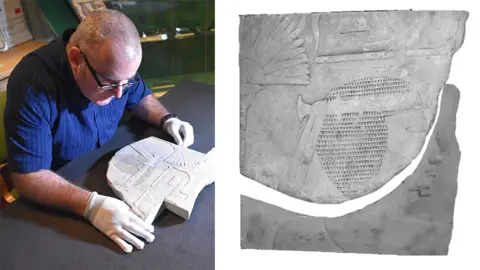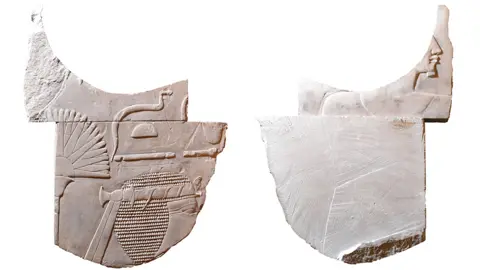Rare female pharaoh artwork found at Swansea University
 Swansea University
Swansea UniversityAn Egyptian artwork that had languished in storage for over forty years has been identified as an extremely rare depiction of one of Egypt's few female pharaohs.
The relief sculpture was discovered at Swansea University's Egypt Centre during a routine student handling session.
It depicts Hatshepsut, one of just five women known to have ruled the empire.
It came to the city in 1971 as part of Sir Henry Wellcome's collection.
The discovery was made by Egyptology lecturer Dr Ken Griffin on International Women's Day.
He said: "I was selecting objects for the handling session, and saw an old black-and-white photo of a carving which looked more interesting than the rest... when we realised what it truly was our jaws hit the floor - mine as well as the students'.
"It wasn't until afterwards I realised it was International Women's Day; Hatshepsut certainly knows how to make an entrance."
 Swansea University
Swansea UniversityThe front side of the carving depicts the head of a figure. The face is missing, with the remains of a fan directly behind.
Traces of hieroglyphs and the icon of the uraeus (cobra) on the forehead of the figure show it was a pharaoh.
Dr Griffin has passed on his findings to the Polish Archaeological Mission to Egypt, which has been excavating, restoring, and recording the temple of Hatshepsut at Deir el-Bahri since 1961.
He hopes between them they will be able to locate the exact spot from which the relief was taken.
Egyptology student Jamie Burns, who was part of the group when the discovery was made, added: "To be involved with identifying this fragment as Hatshepsut is extremely exciting.
"It truly feels like I am part of writing history."
The artwork's days languishing in a dusty warehouse are long-gone - it will now take pride of place in a closely-guarded display case in the House of Life at the Egypt Centre.
